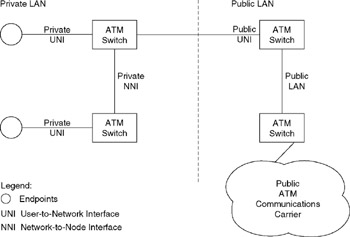2.8 Network Interfaces
2.8 Network Interfaces
ATM supports two types of basic interfaces: the user -to-network interface (UNI) and the network-to-node interface (NNI).
2.8.1 User-to-Network Interface
The UNI represents the interface between an ATM switch and an ATM endpoint. Because the connection of a private network to a public network is also known as a UNI, the terms "public" and "private" UNI were used to differentiate between the two types of user-to network interfaces. That is, a private UNI references the connection between an endpoint and switch on an internal, private ATM network, such as an organization's ATM-based LAN. In comparison, a public UNI would reference the interface between either a customer's endpoint or switch and a public ATM network.
2.8.2 Network-to-Node Interface
The connection between an endpoint and switch is simpler than the connection between two switches. This results from the fact that switches communicate information concerning the utilization of their facilities as well as pass setup information required to support endpoint network requests .
The interface between switches is known as a network-to-node or network-to-network interface (NNI). Similar to the UNI, there are two types of NNIs. A private NNI describes the switch-to-switch interface on an internal network such as an organization's LAN. In comparison, a public NNI describes the interface between public ATM switches, such as those used by communications carriers . Figure 2.18 illustrates the four previously described ATM network interfaces.

Figure 2.18: ATM Network Interfaces
EAN: 2147483647
Pages: 111